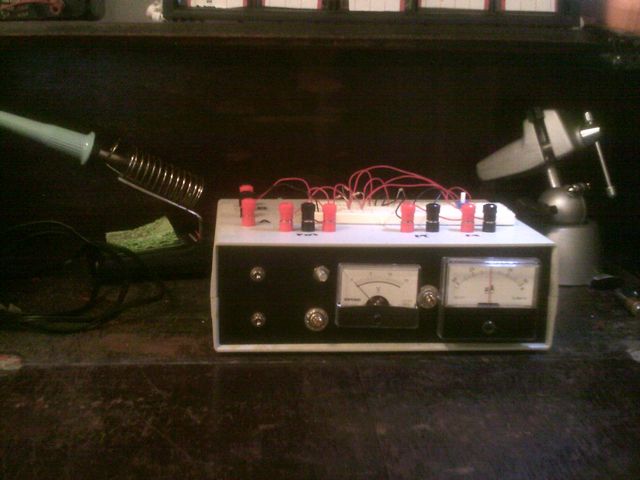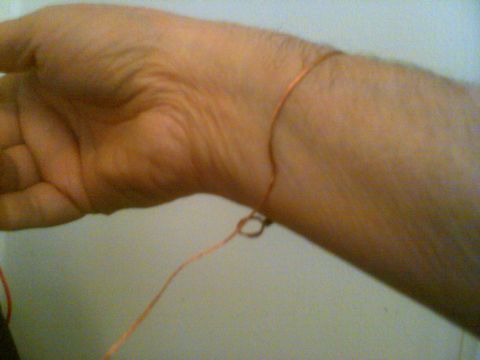Tuesday, March 13, 2018
Se-lu 22, me-zap edition
Finally finished off an electronic project started last summer before the new courseware work popped up.
I was trying to extend Volney Mathison's E-meter to a fully differential setup. I decided to build it into a proper box, with meters and switches and pots mounted permanently. Along the way I realized that the box would be far more useful as a general breadboard lab setup, so I swerved in that direction. The box is a nice lab for all sorts of tube and transistor stuff, with dual-voltage A and B supplies. After long distraction by purposeful work and winter and medical crap, I got it done, and then built the differential Volney on the breadboard.
Here's the box:
 Here is one of my slipknot electrodes, made of desoldering braid**. The two diff inputs go on wrists, the center ground goes on neck.
Here is one of my slipknot electrodes, made of desoldering braid**. The two diff inputs go on wrists, the center ground goes on neck.
 I tried it out, and got nice sensitive diff motion on the meters. One meter shows the side-to-side diff, and the other shows the mean current drawn by both.
BUT: Before I could settle into an experimental mode, I realized the applied voltage was painful on both the wrists and neck, and I could also tell that the voltage was starting to affect brain and heart. Possibly getting into the vagus nerve. I switched off quickly and gave up the attempt.
SE-LU. Loosen yourself. Don't worry about sunk costs and amortizing effort. From now on I'll stick to non-invasive ckts! [But then I made this same promise earlier after another zap experience, and didn't stick to the promise....]
QUESTION: Aside from the differential aspect, this setup applies roughly the same voltage and current to the body as Volney's original tube version. The E-meter, after Hubbard took it over, was considered to be a passive "auditor" in Hubbardese. It wasn't advertised as an active shaper of brain and heart function. When the "therapist" adjusted the E-meter, was he really adjusting the stress response of the victim?
= = = = =
**Hint: Desoldering braid is a wonderful material for making 'organic-like' conductors. It flexes more smoothly than wire, it makes a broader contact with a surface than wire, and by definition it takes solder easily.
I tried it out, and got nice sensitive diff motion on the meters. One meter shows the side-to-side diff, and the other shows the mean current drawn by both.
BUT: Before I could settle into an experimental mode, I realized the applied voltage was painful on both the wrists and neck, and I could also tell that the voltage was starting to affect brain and heart. Possibly getting into the vagus nerve. I switched off quickly and gave up the attempt.
SE-LU. Loosen yourself. Don't worry about sunk costs and amortizing effort. From now on I'll stick to non-invasive ckts! [But then I made this same promise earlier after another zap experience, and didn't stick to the promise....]
QUESTION: Aside from the differential aspect, this setup applies roughly the same voltage and current to the body as Volney's original tube version. The E-meter, after Hubbard took it over, was considered to be a passive "auditor" in Hubbardese. It wasn't advertised as an active shaper of brain and heart function. When the "therapist" adjusted the E-meter, was he really adjusting the stress response of the victim?
= = = = =
**Hint: Desoldering braid is a wonderful material for making 'organic-like' conductors. It flexes more smoothly than wire, it makes a broader contact with a surface than wire, and by definition it takes solder easily.
 Here is one of my slipknot electrodes, made of desoldering braid**. The two diff inputs go on wrists, the center ground goes on neck.
Here is one of my slipknot electrodes, made of desoldering braid**. The two diff inputs go on wrists, the center ground goes on neck.
 I tried it out, and got nice sensitive diff motion on the meters. One meter shows the side-to-side diff, and the other shows the mean current drawn by both.
BUT: Before I could settle into an experimental mode, I realized the applied voltage was painful on both the wrists and neck, and I could also tell that the voltage was starting to affect brain and heart. Possibly getting into the vagus nerve. I switched off quickly and gave up the attempt.
SE-LU. Loosen yourself. Don't worry about sunk costs and amortizing effort. From now on I'll stick to non-invasive ckts! [But then I made this same promise earlier after another zap experience, and didn't stick to the promise....]
QUESTION: Aside from the differential aspect, this setup applies roughly the same voltage and current to the body as Volney's original tube version. The E-meter, after Hubbard took it over, was considered to be a passive "auditor" in Hubbardese. It wasn't advertised as an active shaper of brain and heart function. When the "therapist" adjusted the E-meter, was he really adjusting the stress response of the victim?
= = = = =
**Hint: Desoldering braid is a wonderful material for making 'organic-like' conductors. It flexes more smoothly than wire, it makes a broader contact with a surface than wire, and by definition it takes solder easily.
I tried it out, and got nice sensitive diff motion on the meters. One meter shows the side-to-side diff, and the other shows the mean current drawn by both.
BUT: Before I could settle into an experimental mode, I realized the applied voltage was painful on both the wrists and neck, and I could also tell that the voltage was starting to affect brain and heart. Possibly getting into the vagus nerve. I switched off quickly and gave up the attempt.
SE-LU. Loosen yourself. Don't worry about sunk costs and amortizing effort. From now on I'll stick to non-invasive ckts! [But then I made this same promise earlier after another zap experience, and didn't stick to the promise....]
QUESTION: Aside from the differential aspect, this setup applies roughly the same voltage and current to the body as Volney's original tube version. The E-meter, after Hubbard took it over, was considered to be a passive "auditor" in Hubbardese. It wasn't advertised as an active shaper of brain and heart function. When the "therapist" adjusted the E-meter, was he really adjusting the stress response of the victim?
= = = = =
**Hint: Desoldering braid is a wonderful material for making 'organic-like' conductors. It flexes more smoothly than wire, it makes a broader contact with a surface than wire, and by definition it takes solder easily.
